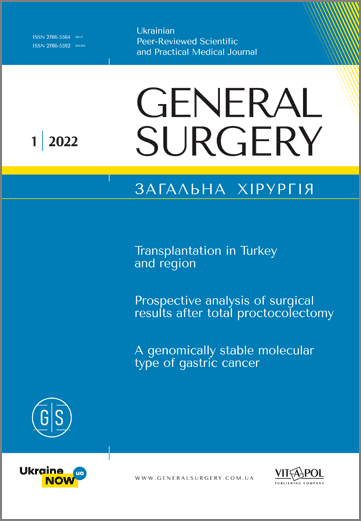Effectiveness of the Erbisol® class in complex treatment of patients with liver cirrhosis
DOI:
https://doi.org/10.30978/GS-2022-1-54Keywords:
liver cirrhosis, management, hepatocytes, Erbisol® class medication, elastographyAbstract
Liver cirrhosis (LC) frequently results in severe complications, high mortality rate and disability in patients suffering from this disease, thus necessitating the study of its course, diagnosis and management. The principle of gradual elimination of pathological syndromes is fundamental in the treatment of LC. Complex therapy requires the use of medicines that act on the general links of pathogenesis. As LC causes damage to the cellular structure of the liver as well as interferes with the normal functioning of other organs and systems, it requires the prescription of medicines with metabolic and immunomodulatory properties. Experimental and clinical results of trials of Erbisol injections necessitated the study of their therapeutic properties in patients with LC. Immunomodulation, hepatoprotection and hepatoreparation play a crucial role in the management of LC.
Objective — to investigate the effectiveness of the Erbisol® class medications in complex treatment of patients with liver cirrhosis.
Materials and methods. The analysis of treatment outcomes in 57 patients with LC was carried out and is presented in this study. Patients were divided into two groups with 28 patients (15 males and 13 females) in the main group and 29 patients (18 males and 11 females) in the control group. All patients received a comprehensive basic therapy for the management of LC. The main group was also prescribed intramuscular injections of the Erbisol® class medicines (Erbisol® Extra, Erbisol® Ultrapharm) that were administered according to the manufacturer’s instructions (Erbis Ukraine, https//erbisol.com.ua). Specific guidelines were followed during the examination of the patients. In both groups, patients with compensated LC had their liver function assessed according to the Child‑Pugh scoring system. Their point scores were added and classified as class B: 8 — 9 points. All patients were distributed according to gender, age, duration of the disease and severity of the main syndromes. The effectiveness of treatment was evaluated based on clinical symptoms, severity, blood tests, elastography ultrasound and Doppler ultrasonography.
Results. The use of Erbisol® medicines significantly improved the dynamics of the clinical course of cirrhosis, relieved astheno‑vegetative disorders, had a pronounced immunocorrective effect that was evidenced by changes in the ratio of serum protein fractions. In the main group, treatment outcomes were characterized by moderate regeneration of the liver parenchyma. It was confirmed by hemodynamic parameters and elastography data. The complex use of Erbisol® drugs helps to slow down and regress fibrosis, contributing to the favorable course of the disease.
Conclusions. Complex treatment with the Erbisol® class medications had a positive action on clinical and blood biochemical parameters and ensured a membrane‑protective effect, regression of fibrosis, and improved hepatic blood flow.
References
Cantero I, Elorz M, Abete I, Marin BA, Herrero JI et al. . Ultrasound/Elastography techniques, lipidomic and blood markers compared to Magnetic Resonance Imaging in non-alcoholic fatty liver disease adults. International Journal of Medical Sciences. 2019; 16(1), 75-83. https://doi.org/10.7150/ijms.28044.
Dzygal OF, Deykalo IM, Gertsev VM. Zastosuvannia reinfuzii astsytychnoi ridyny dlia likuvannia khvorykh iz tsyrozom pechinky. Klinicheskaia Khirurgiia. 2018; 85(8):18-20. DOI: 10.26779/2522-1396.2018.08.18 (Ukrainian).
Garcia-Tsao G, Bosch J, Kayali Z, Harrison SA, Abdelmalek MF, Lawitz E, et al. Randomized placebo-controlled trial of emricasan for non-alcoholic steatohepatitis-related cirrhosis with severe portal hypertension. J Hepatol. 2020; 72:885-95. doi: 10.1016/j.jhep.2019.12.010.
Ge PS, Runyon BA Treatment of Patients with Cirrhosis. N Engl J Med. 2016;375(8):767-777.
Inamova TT, Mirzakarimova DB. Novyi preparat u likuvanni khronichnoho hepatytu erbisol ultrafarm. Novyi den v medytsyni. 2018; 2(22):104-106 (Uzbekistanian).
Kabbany MN, Conjeevaram Selvakumar PK, Watt K, et al. Prevalence of nonalcoholic steatohepatitis-associated cirrhosis in the United States: an analysis of national health and nutrition examination survey data. Am J Gastroenterol. 2017; 112:581-587.
Mansour D, McPherson S . Management of decompensated cirrhosis. Clinical Medicine. Journal of the Royal College of Physicians of London. 2018; 18: s60-s65. DOI:10.7861/ clinmedicine.18-2-s60.
Matkovska NR, Virstiuk NH, Herych PR, Balan UV, Pertsovych YV. Changes in indicators of fibrosis in patients with alcoholic liver cirrhosis associated with non-alcoholic fatty liver disease depending on the stage of cirrhosis Patolohiia. Tom 17, № 1(48), sichen — kviten 2020 r. DOI: 10.14739/2310-1237.2020.1.203626 (Ukrainian).
Papadopoulos N, Vasileiadi S, Michalea S, et al. The use of APRI and FIB-4 scores versus transient elastography for the assessment of liver fibrosis stage in patients with chronic hepatitis C: Is it possible to reduce the need for elastography? Journal of Hepatology. 2019; 70(1): E191-E191. https://doi. org/10.1016/s0618-8278(19)30354-8.
Patel K, Sebastiani G. Limitations of non-invasive tests for assessment of liver fibrosis. JHEP Reports. 2020; 2(2):100067.
Quaranta MG, Ferrigno L, Tata X, D'Angelo F, et al Liver function following hepatitis C virus eradication by direct acting antivirals in patients with liver cirrhosis: data from the PITER cohort..BMC Infect Dis. 2021; May 4;21(1):413. doi: 10.1186/s12879-021-06053-3.
Reddy S, Civan J. From Child-Pugh to model for end-stage liver disease: Deciding who needs a liver transplant. Med. Clin. North. Am. 2016;100(3):449-64. DOI: 10.1016/j.mcna.2015.12.002.
Rusyn AV, Balazh OP. Setsialni metody diahnostyky funktsionalnoho stanu pechinky u khvorykh na tsyroz pechinky. Pytannia khirurhii pankreatobiliarnoi systemyiu DOI: https://doi.org/10.37699/2308-7005.5-6.2020.02 (Ukrainian).
Rueschenbaum S, Ciesek S, Queck A, Widera M, et al. Dysregulated Adaptive Immunity Is an Early Event in Liver Cirrhosis Preceding Acute-on-Chronic Liver Failure. Front Immunol. 2021 Jan 26;11:534731. doi: 10.3389/fimmu.2020.534731.
Wang K, Lu X, Zhou H, et al. Deep learning radiomics of shear wave elastography significantly improved diagnostic performance for assessing liver fibrosis in chronic hepatitis B: a prospective multicentre study. Gut. 2019;68:729-41. DOI: 10.1136 / gutjnl-2018-316204.
Yoshiji H, Nagoshi S, Akahane T, et al. Evidence-based clinical practice guidelines for Liver Cirrhosis. 2020. Gastroenterol. 2021 Jul;56(7):593-619. doi: 10.1007/s00535-021-01788-x. Epub 2021 Jul 7.PMID: 34231046.
Zemlianitsyna OV, Sinaiko VM, Savenkov VI, Kravchun PP, Kravchun NO, Goncharova OA. Non-invasive fibrosis markers and elastography in diagnosis of fibrosis severity in patients with type 2 diabetes mellitus and non-alcoholic fatty liver disease. Zaporozhskyi medytsynskyi zhurnal. 2020;22(1):48. (Ukrainian).






